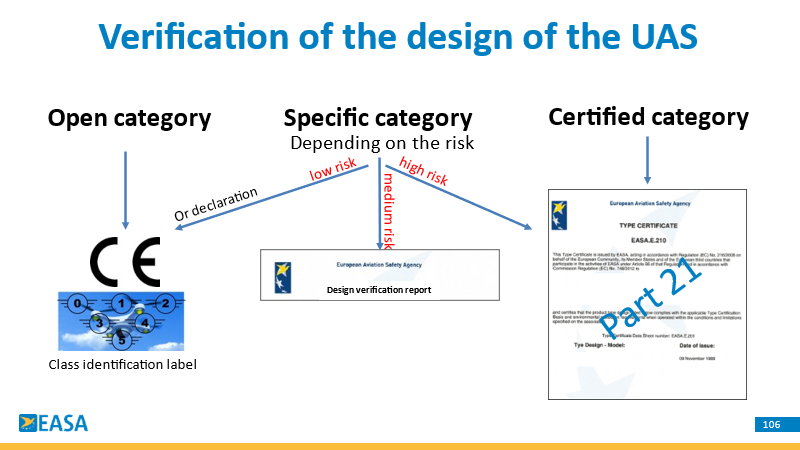In this site you can find:
- EASA guidelines for design approvals
- The Design Verification report (DVR)
- How to apply for a DVR, duration and cost
- What a DVR is not
- Who can apply for a DVR
- Content of the EASA Design Verification Report - DVR
- DVRs issued so far
- Stay informed
EASA guidelines for design approvals
After conducting the SORA, the operator determines the SAIL (the level of intrinsic risk of the operation) and identifies the level of robustness of the operational safety objectives (OSOs) to be demonstrated, as following, for the design related OSOs:
- For SAIL I, II and III operations: an operator may use a drone with a class identification label or with a declaration of compliance of the drone with the technical OSOs. However, for compliance of technical mitigations (M2) and enhanced containment the NAA may ask to use a drone assessed by EASA through a design verification report too in these cases;
- For SAIL V and VI operations (classified as High risk): the use of a drone with a type certificate according to (Regulation (EU) 748/2012) 2 (known as Part 21) is required;
- For SAIL IV operations: a more appropriate, simplified and flexible option exists: the Design Verification Report.
The Design Verification Report (DVR)
This is a report issued by EASA that documents that the UAS design complies with the applicable OSOs, which includes any possible limitations or assumptions the actual drone model needs to operate (see more details below in the design verification basis).
The list of issued design verification report, can be found below.

How to apply for a DVR, duration and cost
Drone manufacturers should apply for a DVR using Application form for Unmanned Aircraft System Design Verification (FO.CSERV.00198).
EASA will conduct first a pre-application meeting where expects from the manufacturer a description of the planned operations as well as timelines/schedules for Design Verification/ certification and entry into the market. In this occasion, EASA experts may provide some useful indications to the manufacturer that may then decide if they believe to be ready for the application or if they prefer to hold it.
After a successful completion of the pre-application meeting, the EASA experts will agree with the manufacturer the applicable requirements derived by the SC light UAS.
As per DVR guidelines, applicants should submit a proposal for the MoCs intended to be used to demonstrate compliance with requirements of SC Light UAS, and this set of MoCs will have to be agreed with EASA. The Table of MoCs to SC Light UAS may support applicants to formulate their proposal.
The manufacturer will gather the documentation to show compliance with the applicable requirements and will submit it to EASA. After positive evaluation of the documentation EASA will issue the DVR. The duration of the process is heavily dependent on the complexity of the system to be assessed and on the responsiveness of the manufacturer to demonstrate compliance properly.
The cost for a DVR will be based on the actual time spent by EASA staff on assessing the documentation. EASA will charge using the applicable hourly rate equal to 250 Euro.
Operators applying for an operational authorization using a drone having a DVR issued by EASA appropriate for such operation, will be able to show compliance to the design related OSO through the DVR.
What a DVR is not
An operator having a Light UAS operator Certificate (LUC) can’t have the privilege to assess compliance of a drone with the design requirements. So based on the SAIL of the operation they conduct, they may need to use a drone assessed by EASA through a DVR.
A Design Verification Report is a not a type certificate, and it is recognised only throughout EASA Member States.
Who can apply for a DVR
Any natural or legal person can apply. The applicant needs to be capable of demonstrating design compliance of a UA, mitigation means or containment capabilities (as applicable) as shown above.
The need for a DVR will be specified by the NAA in the operational authorisation. However, manufacturers may also decide, due to business considerations, to apply to EASA for a design verification independently of a request from the NAA.
Content of the EASA Design Verification Report - DVR
It will include:
- Reference to applicable documents from the manufacturer
- Suitable SAIL, Ground and Air Risk class, operational environment, etc. for the drone design.
- Conditions / limitations under which the design is expected to perform adequately including as applicable e.g.
- minimum ground/air buffers
- Limits for density of population
- RF environment
- Specific elements regarding Continuing Airworthiness – CAW
- Etc.
Check the DVR guidelines for more details:
Guidelines on Design verification for UAS operated in the ‘specific’ category are also relevant.
DVRs issued so far by EASA
View the Drones design database.
 Stay informed on DVR:
Stay informed on DVR:
- Create an EASA account
- Follow the category "Civil Drones (Unmanned aircraft)"
- Decide how you want to be notified